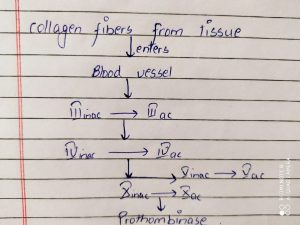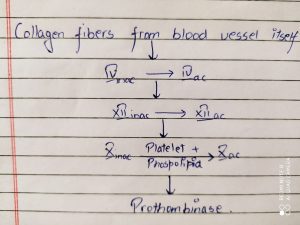Hemostasis and Blood Clotting MCQs For NEET, GPAT, Pharmacist,SSC and Staff Nurse Exam
Hemostasis is a series of process which stops bleeding, when the blood vessel is broken or damaged this process takes place.
Hemostasis is done through three steps or mechanisms which are as follows-
- Vascular spasm:-when arteries and arterioles are damaged, the smooth muscles which are arranged in circular pattern in the walls of blood vessels starts contracting; this reaction or process is known as vascular spasm. This help reduce blood loss for several minutes to several hours, by the time the other two mechanism of hemostasis takes place. The spasm occurs due to the damage to the smooth muscle, due to the release of substances from activated platelets or due to the reflex initiated by pain receptors.
- Platelet plug formation:– platelets contains numerous of chemicals within its vesicles which includes- clotting factors, ATP, ADP, Ca ions, serotonin etc. they also contains lysosomes, and enzymes which produces thromboxane A2, some mitochondria and many more. Platelet plug formation takes place in 3 steps; which are as follows
- Initially the platelets contact and stick to the parts of damaged blood vessel like the collagen fibers or deep to it the endothelial cells. This step is known as platelet adhesion.
- Due to adhesion, the platelets become activated and certain changes takes place in their characteristics, like they tend to extend their projection which helps them to contact and interact with one another and also they start releasing contents from their vesicles. This step is known as platelet release reaction. The ADP and thromboxane A2 activates other platelets, serotonin works as vasoconstrictor causing contraction in the blood vessels which reduces blood loss.
-
- ADP makes the area sticky and because of this sticky texture, the newly activated platelets comes in contact with the originally activated platelets. This gathering of platelets is called as platelet aggregation. In this way, the attachment of several platelets form a mass which is known as platelet plug.
- Blood coagulation/clotting:– it is the process by which blood clot is formed. It takes place in three steps with the help of clotting factors which are:-
- Fibrinogen
- Prothominogen
- Tissue factor
- Ca ions
- Proaccelerin
- No clotting factor
- Stable factor
- Anti hemophilic factor A
- Christmus factor
- Prowar factor
- Pre anti hemophilic factor B
- Hageman factor
- Fibrin stabilizing factor
Using these clotting factors and following the 3 steps the clot is formed, these three steps are
- Formation of prothrombinase
- Formation of thrombin
- Formation of strong fibrin thread
There are two pathways in blood clotting
- Extrinsic pathway:– if the collagen fibers comes from tissue to the blood vessel. The first steps in extrinsic pathway occur by following mechanism

- Intrinsic pathway:- if the collagen fibers are of blood vessel itself

There is difference in the formation of first step of the clot, the other two steps are same for both the pathways

Due to injury at certain point of our body, the concentration of clotting factors increases which directs them to make fibrin thread, that’s why thin fibrin threads is not formed at other places.
After the complete repairing of the injury, plasminolysin which is present in an inactive form with the clot becomes activated and dissolves the formed clot, this process is known as plaminolysis.

Modified from B. Ciesla, Hematology in Practice, F. A. Davis Company, Philadelphia, PA, 2007.
Above figure is taken from article Coagulation cascade (https://www.sciencedirect.com/topics/engineering/clotting-cascade) for Education purpose only
Multiple choice questions(MCQs)
1. What do you mean by Hemostasis?
A. production of new blood cells
B. process by which bleeding stops from damaged blood vessels
C. normal body condition
D. none of the above
2. Which of the following are the 3 steps of hemostasis?
A. vascular spasm, platelet adhesion, blood clotting
B. vascular spasm, platelet plug formation, blood clotting
C. vascular spasm, platelet aggregation, blood clotting
d. vascular spasm, platelet release, blood clotting
3. Why vascular spasm takes place?
A. due to damage in smooth muscle
B. due to release of substances by activated platelets
c. due to the reflex initiated by pain receptors
D. all of the above
4. Which of the following options does not come under the substances released by activated platelets?
A. serotonin B. ADP
C. urea D. Ca ions
5. Which substance along with thromboxane A2 helps activate other platelets during platelet plug formation?
A. serotonin B. ADP
C.ATP D. lysosomes
6. Match the following-
a) Vascular spasm 1. Extend projection and
B)Platelet adhesion liberate substances
C) Platelet release action 2. Causes contraction in walls of blood vessel
D) Platelet accumulation 3. Sticking on the damaged part
4. gathering of all the platelets
7. which of the following is the (iv) clotting factor?
A. Proaccelerin B. tissue factor
C. stable factor D. none of the above
8. Which of the following statement is NOT true?
A. hemostasis prevents hemorrhage
B. platelet plug is very effective in preventing blood loss from large blood vessels
c. vitamin K is required for synthesis for several clotting factors
d. the clot formed is a gel like substance
9. Which of the following is effective in dissolving the clot formed after complete repair of injury?
A. hageman factor B. plasminolysin
C. christmas factor D. tissue factor
10. Which of the following do not take part in the extrinsic pathways for the formation of prothrombinase?
A. tissue factor B. prowar factor
C. stable factor D. Ca ions
ANSWERS:-
- process by which bleeding stops from damaged blood vessel
- vascular spasm, platelet plug formation, blood clotting
- all of the above
- urea
- ADP
- a) – 2 b) – 3 c) – 1 d) – 4
- none OF THE above
- platelet plug is very effective in preventing blood loss from large blood vessels
- plasminolysin
- stable factor
List of Successful GPATINDIAN CANDIDATES
Participate in Online FREE GPAT TEST: CLICK HERE
Participate in Online FREE Pharmacist TEST: CLICK HERE
Participate in Online FREE Drug Inspector TEST: CLICK HERE
Participate in CSIR NET JRF Mock Test
REFERENCE:– Gerard J. Tortora -Principles of anatomy and physiology; edition twelfth ; page no.-: 703-707.